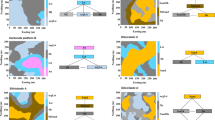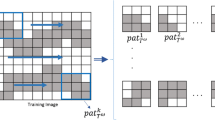Abstract
We present a probability conditioning method (PCM) for constraining multipoint statistical (MPS) facies simulation to nonlinear flow data. MPS has recently been introduced for flexible grid-based simulation of spatial connectivity in formations containing discrete geologic objects (e.g., fluvial channels) that are not amenable to conventional two-point geostatistical modeling. Using the higher-order statistics in MPS, facies realizations are simulated from a conceptual geologic continuity model known as a training image (TI). As a result, the simulated realizations inherit the complex structural connectivity and multipoint spatial statistics conveyed-by the TI. While conditioning multipoint simulation results on static hard (e.g., core) and soft (e.g., three-dimensional seismic) measurements is relatively straightforward, conditioning the simulated facies on nonlinear flow data is a nontrivial task. On the other hand, inversion methods that directly update post-simulation facies distributions have difficulty in reproducing the spatial connectivity (or higher-order statistics) implied by a TI. Using the PCM approach, we first invert the flow data to obtain a probabilistic spatial description of facies distribution (i.e., a probability map) and use the resulting facies probability map to guide MPS facies simulation from a specified TI. Since the probability map contains important information about the flow measurements, the simulated facies distributions are more likely to reproduce the observed flow data. While the proposed PCM approach can be used with different inversion algorithms, we choose the ensemble Kalman filter (EnKF) to extract facies distribution probabilities from flow data. We make this choice because (i) the ensemble form of the EnKF is less sensitive to discontinuity and nonuniqueness (randomness) introduced in conditioning facies simulation on a probability map, and (ii) the EnKF has been established as an effective subsurface data assimilation approach. The PCM implementation with the EnKF results in an improved performance of the filter updates, namely through the preservation of the facies correlation structure and the introduction of additional ensemble variability (spread) due to the resampling of facies from the TI after each update step. We discuss the important properties of the proposed PCM method and illustrate its effectiveness using several two-dimensional waterflooding problems in reservoirs containing two and three facies types. We conclude that PCM effectively combines the existing information in the flow data and the TI; it does so by using the former to infer probabilistic knowledge about inter-well and near-well spatial connectivity and the latter to ensure consistent facies structure and connectivity, where the flow data are inconclusive (e.g., away from measurement locations).
Similar content being viewed by others
References
Aanonsen SI, Naevdal G, Oliver D, Reynolds AC (2009) The ensemble Kalman filter in reservoir engineering—a review, paper spe-117274-pa. Soc Pet Eng J 14(4):393–412
Agbalaka C, Oliver D (2008) Application of the EnKF and localization to automatic history matching of facies distribution and production data. Math Geosci 40(4):353–374
Arpat G, Caers J (2007) Conditional simulation with patterns. Math Geol 39(2):177–203
Brouwer R, Jansen J (2004) Dynamic optimization of waterflooding with smart wells using optimal control theory. Soc Pet Eng J 9(4):391–402
Caers J (2005) Petroleum geostatistics. Soc Pet Eng
Caers J, Hoffman T (2006) The probability perturbation method: a new look at Bayesian inverse modeling. Math Geol 38:81–100
Caers J, Zhang T (2004) Multiple-point geostatistics: a quantitative vehicle for integrating geologic analogs into multiple reservoir models. In: Grammer GM (ed) AAPG memoir, integration of outcrop and modern analogs in reservoir modeling, vol 80, pp 383–394
Chiles J, Delfiner P (1999) Geostatistics: modelling spatial uncertainty. Wiley series in probability and mathematical statistics
Deutsch C, Journel A (1998) GSLIB—geostatistical software library and user’s guide. Oxford University Press, London
Deutsch C, Wang L (1996) Hierarchical object-based stochastic modeling of fluvial reservoirs. Math Geol 28(7):857–880
Dimitrakopoulos R, Mustapha H, Gloaguen E (2010) High-order statistics of spatial random fields: exploring spatial cumulants for modelling complex, non-Gaussian and non-linear phenomena. Math Geosci 42(1):65–97
Dorn O, Villegas R (2008) History matching of petroleum reservoirs using a level set technique. Inverse Problems 24:035015 (29 pp)
Dovera L, Rossa ED (2007) Ensemble Kalman filter for Gaussian mixture models. In: Petroleum geostatistics 2007, 10–14 September, Cascais, Portugal, A16
Evensen G (1994) Sequential data assimilation with a non-linear quasi-geostrophic model using Monte Carlo methods to forecast error statistics. J Geophys Res 99:143–162
Evensen G (2003) The ensemble Kalman filter: theoretical formulation and practical implementation. Ocean Dyn 53:343–367
Evensen G (2004) Sampling strategies and square root analysis schemes for the EnKF. Ocean Dyn 54:539–560
Gavalas G, Shah P, Seinfeld J (1976) Reservoir history matching by Bayesian estimation. Soc Pet Eng J 16(6):337–350
Gelb A (1974) Applied optimal estimation. The MIT Press, Cambridge
Gu Y, Oliver D (2007) An iterative ensemble Kalman filter for multiphase fluid flow data integration, paper spe-108438-pa. Soc Pet Eng J 12(4):438–446
Guardiano F, Srivastava R (1993) Multivariate geostatistics: beyond bivariate moments In: Geostatistics-Troia, vol 1, pp 133–144. Kluwer Academic, Dordrecht
Houtekamer PL, Mitchell HL (1998) Data assimilation using an ensemble Kalman filter technique. Mon Weather Rev 126:796–811
Jacquard P, Jain C (1965) Permeability distribution from field pressure data. Soc Pet Eng J 5(4):281–294
Jafarpour B (2010) Wavelet reconstruction of geologic facies from nonlinear dynamic flow measurements. IEEE Trans Geosci Remote Sens. doi:10.1109/TGRS.2010.2089464
Jafarpour B, McLaughlin D (2009a) Estimating channelized reservoir permeabilities with the ensemble Kalman filter: the importance of the ensemble design. Soc Pet Eng J 14(2):374–388
Jafarpour B, McLaughlin D (2009b) Reservoir characterization with discrete cosine transform. Part-1: Parameterization; Part-2: History matching. Soc Pet Eng J 14(1):181–202
Jafarpour B, Tarrahi M (2010) Assessing the performance of the ensemble Kalman filter for subsurface flow data integration under variogram uncertainty. Water Res Res. doi:10.1029/2010WR009090
Jahns O (1966) A rapid method for obtaining a two-dimensional reservoir description from well pressure response data. Soc Pet Eng J 6(12):315–327
Jazwinski A (1970) Stochastic processes and filtering theory. Academic Press, San Deigo
Journel A (2002) Combining knowledge from diverse sources: an alternative to traditional data independence hypotheses. Math Geol 34(5):573–596
Kailath T, Sayed A, Hassibi B (2000) Linear estimation. Prentice Hall, New York
Kalman R (1960) A new approach to linear filtering and prediction problems. Trans ASME J Basic Eng 82:35–45
Liu N, Oliver D (2005) Ensemble Kalman filter for automatic history matching of geologic facies. J Pet Sci Eng 47(3–4):147–161
Lorentzen R, Nævdal G (2011) An iterative ensemble Kalman filter. IEEE Trans Automat Control (submitted)
Lorentzen R, Nævdal G, Lage A (2003) Tuning of parameters in a two-phase flow model using an ensemble Kalman filter. Int J Multiph Flow 29:1283–1309
Mirowski P, Tetzlaff D, Davies R, McCormick D, Williams N, Signer C (2008) Stationarity scores on training images for multipoint geostatistics. Comput Geosci 41(4):447–474
Mitchell H, Houtekamer P, Pellerin G (2002) Ensemble size, and model-error representation in an ensemble Kalman filter. Mon Weather Rev 130:2791–2808
Moreno D, Aanonsen S (2007) Stochastic facies modeling using the level set method. In: In petroleum geostatistics, 10–14 September 2007, Cascais, Portugal, A18
Mustapha H, Dimitrakopoulos R (2010) High-order stochastic simulations for complex non-Gaussian and non-linear geological patterns. Math Geosci 42(5):455–473
Nævdal G, Johnsen L, Aanonsen S, Vefring EH (2005) Reservoir monitoring and continuous model updating using ensemble Kalman filter. Soc Pet Eng J 10(1):66–74
Oliver D, Reynolds A, Liu N (2008) Inverse theory for petroleum reservoir characterization and history matching. Cambridge University Press, Cambridge
Reichle R, McLaughlin D, Entekhabi D (2002) Hydrologic data assimilation with the ensemble Kalman filter. Mon Weather Rev 130:103–114
Remy N, Boucher A, Wu J (2009) Applied geostatistics with SGeMS: a user’s guide. Cambridge University Press, Cambridge
Reynolds A, He N, Chu L, Oliver DS (1996) Reparameterization techniques for generating reservoir descriptions conditioned to variograms and well-test pressure data. Soc Pet Eng J 1(4):413–426
Reynolds A, Zafari M, Li G (2006) Iterative forms of the ensemble Kalman filter. In: Proceedings of 10th European conference on mathematics of oil recovery, 4–7 September, Paper A030
Robert C, Casella G (2005) Monte Carlo statistical methods, 2nd edn. Springer, Berlin
Roggero F, Hu L (1998) Gradual deformation of continuous geostatistical models for history matching. SPE 49004 presented at the 1998 SPE annual technical conference and exhibition, New Orleans, LA, 27–30 September 1998
Sarma P, Durlofsky L, Aziz K (2008) Kernel principal component analysis for efficient, differentiable parameterization of multipoint geostatistics. Math Geosci 40(1):3–32
Skjervheim J, Evensen G, Aanonsen S, Johansen T (2007) Incorporating 4d seismic data in reservoir simulation model using ensemble Kalman filter. Soc Pet Eng J 12(3):282–292
Strebelle S (2002) Conditional simulation of complex geological structures using multiple-point statistics. Math Geol 34(1):1–22
Tikhonov A, Arsenin V (1977) Solution of ill-posed problems, Winston, PA
Wen X, Chen W (2006) Real-time reservoir model updating using ensemble Kalman filter with confirming option. Soc Pet Eng J 11(4):431–442
Wen X, Chen W (2007) Some practical issues on real-time reservoir model updating using ensemble Kalman filter. Soc Pet Eng J 12(2):156–166
Zhang T, Switzer P, Journel A (2006) Filter-based classification of training image patterns for spatial simulation. Math Geol 38(1):63–80
Zhao Y, Reynolds A, Li G (2008) Generating facies maps by assimilating production data and seismic data with the ensemble Kalman filter, paper spe113990. In: Proceedings of SPE/DOE symposium on improved oil recovery, Tulsa, 20–23 April
Author information
Authors and Affiliations
Corresponding author
Rights and permissions
About this article
Cite this article
Jafarpour, B., Khodabakhshi, M. A Probability Conditioning Method (PCM) for Nonlinear Flow Data Integration into Multipoint Statistical Facies Simulation. Math Geosci 43, 133–164 (2011). https://doi.org/10.1007/s11004-011-9316-y
Received:
Accepted:
Published:
Issue Date:
DOI: https://doi.org/10.1007/s11004-011-9316-y




